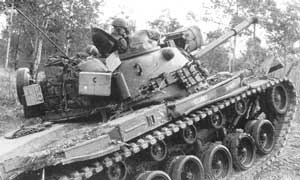
Recollections of a 1/4 Cav Veteran
Submitted by John Sandri

These pages are dedicated to the memory of SSG Roosevelt Williams, KIA,
An Loc, RVN, Oct 1968
Use this info however you wish, with or without my name, although it might be helpful for others to know where the info comes from. Someone should be recording the practical, not the supposed, experience.
For example, how do you suppose that in a well coordinated M48 crew (mine) the TC could be firing the 50 cal, main gun and also 'training the gun' nearly simultaneously while the loader fired the coaxial 7.62, the m60 on top (in front of his hatch) and load the main gun? Can you figure it all out?
Here's the answer:
The TC override was always taped so that the TC could target left or right and elevate/depress the gun with his right foot. A lanyard was run from the manual fire lever of the main gun to the handle for turning the cupola, the TC could then fire the 50 which was mounted on top (an M2, we didn't use the cupola M85 at all), maneuver the main gun and fire it almost all at the same time.
The loader would fire the co-ax by kicking the back plate while standing on the loaders seat and out the top of the hatch, fire his M60 or M16 at the same time (it took some practice but it worked).
I suspect that you already know this but we didn't really do much target selection. By nature we were large, noisy targets, subject to ambush and surprise attack from the enemy. Therefore, survival in the the first minutes of a fight was all important and we laid down a massive wall of constant suppressive fire in all directions. Within 5 minutes each vehicle would expend 100-200 rounds of 50 cal, equal amounts of 7.62, and the 'Bigboys' 5-10 rounds of canister.
M48 and SHERIDAN
I served with 1/4 Cav of the First Infantry Div from 68-70 in third platoon of Alpha Troop, first as an M48 driver and then as TC.
The platoon was composed of 3 x M48A3s and 7 x M113 ACAVs and never gave up the '48s for Sheridan's.
|
|
Although higher ups may have thought of the platoons as having a "scout" section, we never spilt up the platoon that way. If given two missions (this was not usual) a Bigboy (M48) always went with several ACAVs. The platoon was kept as a 10 vehicle fighting unit over 95% of my two years in the field.
How did quarter Cav retain the M48 and not get Sheridans? As always many factors. What was most deciding, who knows?
a) All the BRO ('Big Red One', 1st Infantry Division) Commanding Generals, starting with Seaman and DePuy, fought for the tank's deployment and use. This was passed on to successive commanders. DePuy, as I understand it, was forever trying out missions for the tanks long before it became accepted knowledge that they actually did well in most of the Third Corps.
b) TET proved their usefulness beyond all doubts, at all command levels, and cemented their place with BRO commanders and squadron commanders. After TET (the time I got there) the Bigboys were going everywhere on every mission.
c) The experiences of 11th ACR, the 'Sheridan Scare' if you will, spread like a wildfire - couldn't bust jungle, couldn't take an RPG hit, was weapons and mechanically unreliable, and COULDN'T TAKE A DECENT ANTI TANK MINE.
d) Point "c" led to near revolt in 1/4 Cav at a time when the entire US Force was getting in a mutinous attitude. The 'tankers' (me included) were asking to transfer to the 34th Armor or just to get on ACAVs.
e) Part of 3/4 Cav's problems/adjustments came with lack of stand down for training by the 48 crews and that was going to be repeated with us. There was no time to pull crews for training what with their consistent field deployment.
f) The 11th ACR was replacing ACAVs with Sheridans but retaining their M48 tank companies, we would have lost all the 48's and none of the COs accepted that tradeoff.
g) Lastly, the BRO was going stateside in early 70 and the change was not worth the effort for such a short time. If my mind is correct we got the final word around Nov '69 that the 3/4 and 11th were sufficient 'experiments' of the Sheridan and that we were now exempt.
1/4 CAV LINE PLATOON
The third platoon of alpha troop - dragoon alpha november
- zero(30) ACAV
- one (31) ACAV
- deuce(32) ACAV
- three(33) ACAV (medic)
- four(34) M48
- five(35)M48 (plt sergeant)
- six(36) ACAV (plt leader)
- seven(37) M48
- eight(38) ACAV
- niner(39) ACAV
Mortar and Infantry Track: we had no mortar track, though I do recall seeing a mortar track when I first got to 3rd platoon. I don't think it was one of our vehicles, I never saw it again, ditto the infantry track - we barely had 4-man crews to cover driver, commander and two side gunners, and getting off on to the ground was very rare (only to search a base camp after blowing it to pieces and running over everything, to count bodies etc.) we just pulled one man from each crew of 4 or more.
ARMAMENTS (besides the standard stuff)
1. By Feb '68 the ACAVs were acquiring (don't ask how) a second M60 so that they had a 50cal. and two m60
2. All vehicles acquired thump guns (M79 grenade launchers) including the M48s
3. By Nov '68 the tanks also had a m60 in front of the loaders hatch for the loader to fire between feeding main gun rounds. We initially had gun-shields for them but the brass spotted them and all the 'extra' weapons were confiscated. Thereafter, by Dec '68, the extra weapons were more concealed
4. By that time, Dec '68 - Jan '70, 38 and 39er replaced a M60 with a 50 cal (38 on the right side and 39er on the left). They then had 2 x 50 cal and 1 x M60, and were always right flank (38) or left flank (39er) in any formations
Ammo Loads
M48 main gun: initially we had 4 HEAT, 6 HE and the rest (approximately 50 rounds?) were canister. After about June/July '68 we dropped the HEAT. The early cannister had little metal cylinders (about 700 per round) whilst the later ones had flechettes (like little nails with fins, about 1200 per round). The early rounds with the cylinders were great jungle busters. In thick jungle, especially bamboo thickets, the lead tanks would prepare the way by clearing with canister. More canister by far was used for this than in firefights. A lead tank would consume 8-14 rounds a day this way.
As for 50-cal and 7.62mm etc., who counted? There were 8 boxes of 50-cal on each side of the front fenders in front of the sponson for a total of 1600 rounds (a box = 100 rounds). 6 boxes of 7.62mm each side rear fenders ( =1200rds), a full load in the coax bin (= about 2000, check this if you can I really don't know how much that box held, I'm guessing). The bussel rack was full of 50-cal and 7.62mm (about 75% of this was 50-cal and 25% was 7.62mm). The turret compartment ammo boxes that come with the tank were stripped out and the turret floor covered by 50-cal and 7.62mm ammo boxes..... my best guess here is about 5000 rounds of 50-cal and 5000 of 7.62mm. We each had 20 magazines of M16 (5.56mm) in bandoliers and a box or two (= about 2000+ rounds). Had about 10-20 hand grenades and a case of M79 HE rounds. Add some trip flares, hand flares and smoke grenades and that's about it
ACAVs? Got me on this one. The bench seats were stacked two deep with 50-cal and 7.62mm, as well as under the seats and covering the floor... best guess is 15,000+ rounds. Aside from that they had 4-6 LAWs each, M79 etc.
FORMATIONS
These formations assume full strength units which was not all that common and so in real life vehicle positions were often missing although the general configuration was maintained. Remember that 34, 35 and 37 are the M48's, 33 had the 'Doc' and 36 the platoon leader.
1 . March and/or Jungle Busting
 |
|
Platoon Single Column |
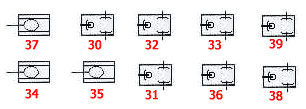 |
|
Platoon Double Column |
In any single column formation weapons were "herring bone" that is facing opposite side of vehicle in front of you.
In an ambush the column would close with each vehicle turning off in its gun direction firing all the time.
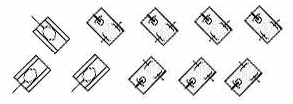 |
| Herringbone Defence |
At no time would an M 48 driver allow the gun tube to be over his head (in case of hitting a mine and being ejected or just needing to get out quick) so the lead M 48 set the herring bone pattern.
2. Battle Formations
You have heard of ' wedges' and ' echelons' ( right and left), but we rarely used or did that stuff except sometimes in open terrain and more for show or practice. Mainly we were in a 'box' or a 'line'.
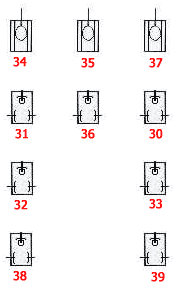 |
|
Box Battle Formation |
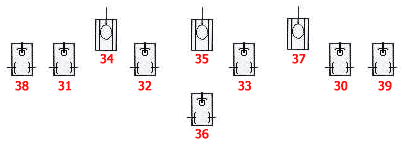 |
|
Line Battle Formation |
ACAV's lined up with their front sprocket aligned with the rear sprocket of the M48 in order to avoid side blast from the main gun. So I'm showing them slightly behind the 48's.
3. Convoy Escort
| Unit in Convoy Formation |
First, I did lots of convoy escort in two years and never got ambushed, just a few sniper rounds. The platoon did respond as reaction force to several ambushes, though this was all HWY 13 or "Thunder Road".
Anyway, there was a "Plan" (Convoy SOP ) but, like one of the other troopers on your web page mentioned, once the shooting started anything went.
SOP: I like to think of it as peeling a banana, the lead tanks would come about on either side of the road, and/or regain the road, for faster return to the site of ambush. Those parts of the convoy ahead of the ambush site continued on with their MP escorts (2 jeeps with M60s). Trailing convoy elements turned around or backed down the road. Truckers at the site were "on their own" as our other vehicles peeled off and traveled to the ambush site on both sides of the road. This provided some 'cacooning' of the retreating convoy elements and would cover both sides of the road. Even as a reaction force it was never perfectly clear whether there was a one sided, two sided or L-shape ambush etc. I can remember one time when we were a reaction force and told the ambush was from the West side when it turned out it was from both sides of the road in July '69.
The division convoys were very consistent in format - not the best idea to me - with the JP4 fuel tankers always in the lead and a prime target. I don't know how they had the guts to get in those cabs everyday.
The truckers were frustrated by our speed too. We traveled much slower than they could and speed meant safety to them. By the way, one of the data sheets said M48 top speed was 40mph whereas 32mph was the max. I did get one up to 42mph down the long hill from Quan Loi to An Loc once but it became impossible to handle, every little bump and rut sent it bouncing all over the road.
The convoy route from Saigon to An Loc (HWY 1A and 13) was progressively paved with asphalt and as our escorting progressively moved northward so the road got paved... i.e. we escorted on the unpaved sections.
Convoy escort was the best job. Risks were low and after you got your section of road done and another platoon or unit picked up the next section, you had 2-3 hours waiting for the return convoy of empty trucks. These stop areas were like mini parties with the Vietnamese locals selling everything you can image, or getting it for you within a couple of days.
The down side was that the vehicles required lots of maintenance and you'd spend half the night on oiling, greasing, repairing, replacing etc.
CREWS
M48 crew = 4: Tango Charlie (commander), Delta (driver), Lima (loader) and Golf (gunner) who rode the bussal rack and faced rear. Nobody sat inside or rode inside. I was 35 lima, 35 delta, 37 tango charlie and 34 tango charlie for my time I was in-country. Formal communication in squadron was: "this is dragoon alpha november 34 tango charlie, over", and at troop/platoon it was "this is november 34, over" or "this is 34, over"
ACAV crew = 4/5: TC, Driver, 2 Gunners, fifth would act as rear gunner/ammo distributor. Tracks 33 and 36 would have 5-6 to account for the medic and platoon leader. In reality the medic was usually a gunner too.
Platoon was rarely at full strength. We had a platoon leader less than 40% of my 2yrs and us teenagers and a lifer E6 or E7 ran the platoon. I arrived post TET, Feb '68, and the platoon had lost 34,30 and 38. Track 32 was at squadron maintenance. Both 34 and 37 were left at Phu Loi with 2 TC's and one driver, the loaders and gunners were sent to fill out the ACAV crews. a new 34 arrived the first week in March. By mid Oct '68 I was the longest in country member of the third platoon!!!
Lighter stuff to end.... cooking: since weight wasn't a problem we'd carry 5-10 cases of C-rations and had a merck can (cooler) strapped to the bussel rack for cold sodas and beer.... ice, sodas and beer were a major resupply request everyday. Any way, end connectors made for great mini stoves and we'd put a little C4 plastic explosive in the center of the end connector, place a C ration can on top and light the C4, stirring so as not to burn things at the bottom of the can. Works even in a torrential down pour. Some of us would get jiffy-pop popcorn in care packages from home and cook it this way. "Pizza" could be made by combining the bread, spaghetti, and cheese spread in layers in an emptied can from another meal.
